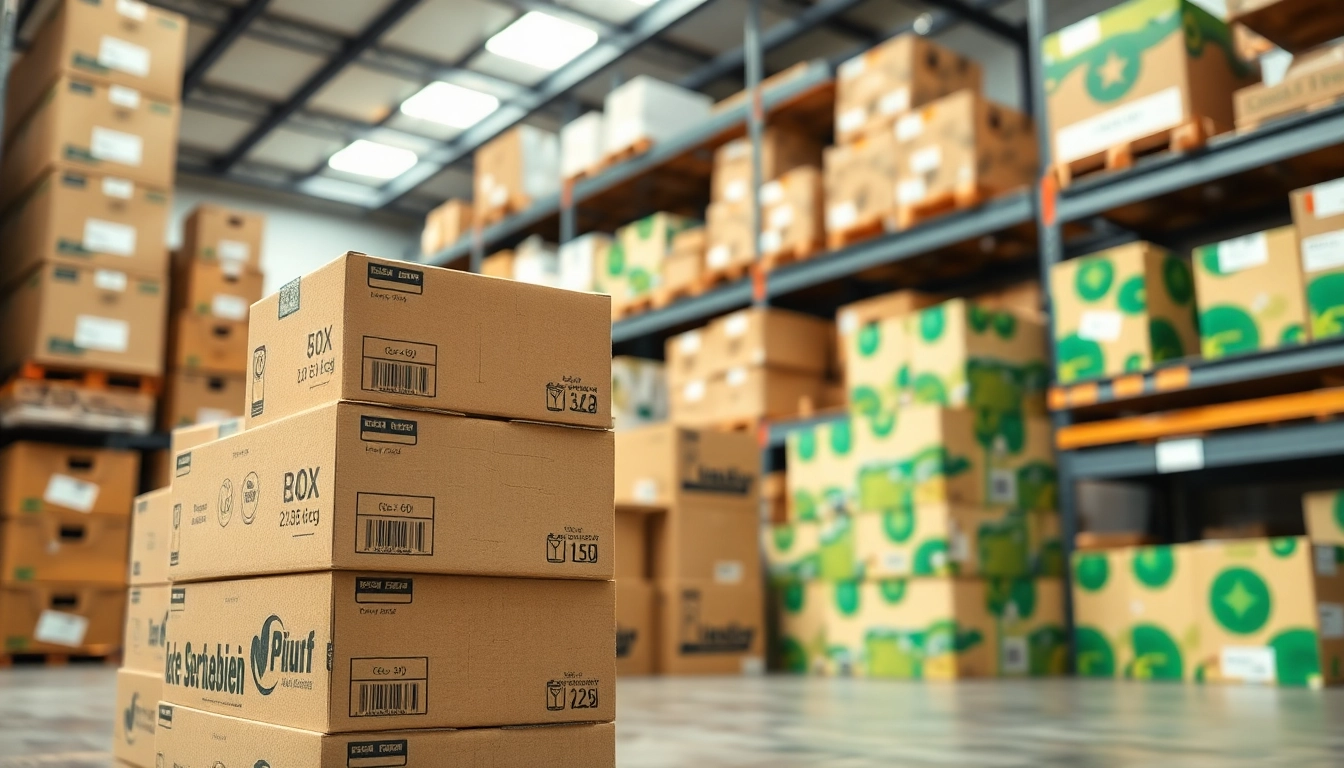Understanding Different Types of Boxes
When it comes to packaging, the choice of boxes is crucial for ensuring the safety and integrity of your items during transit or storage. Boxes come in a variety of materials, styles, and sizes, each suited for different purposes. Understanding the different types of boxes available allows you to select the best option for your needs. From moving your items across town to sending gifts across the country, the right box can make all the difference. Whether you need boxes for shipping or organization, this guide will help you explore the options available.
1.1 Cardboard vs. Plastic Boxes
Cardboard boxes are the most common type of box used for shipping and storage due to their lightweight and recyclable nature. They are made from a material called paperboard or corrugated fiberboard, which provides strength while keeping the weight down. Cardboard boxes come in various styles including single-wall, double-wall, and triple-wall configurations, each with different weight capacities.
Plastic boxes, on the other hand, are more durable and resistant to moisture and pests. They are ideal for long-term storage in humid environments or for shipping items that require added protection from the elements. While plastic boxes tend to be more expensive than their cardboard counterparts, they can be reused multiple times, making them a worthwhile investment for those who frequently move or ship items.
1.2 Specialty Boxes for Unique Items
When shipping or storing items that are fragile, unusually shaped, or have special requirements, specialty boxes become essential. These boxes come in sizes and configurations designed specifically for items such as wine bottles, artwork, electronics, and more. For instance, wine shipping boxes often feature inserts to secure each bottle and protect against breakage during transit.
Additionally, custom boxes can be created for oversized items or those with irregular shapes, such as sculptures or machinery parts. These specialty boxes typically come with cushioning materials, like foam or bubble wrap, to ensure that the contents are safeguarded from impacts and vibrations.
1.3 Eco-Friendly Alternatives
As awareness about environmental sustainability grows, eco-friendly box options have gained popularity. These boxes are made from recycled materials or are designed to be biodegradable, minimizing negative impacts on the environment. Many packaging manufacturers are now offering boxes created from post-consumer waste, which can be recycled again after use.
In addition to traditional paperboard boxes, other eco-friendly options include those made from cornstarch, mushrooms, and even bamboo. These alternatives provide the same protective qualities as conventional boxes while reducing the carbon footprint associated with extensive manufacturing processes. Choosing eco-friendly boxes not only benefits the environment but can also enhance your brand’s image among environmentally-conscious consumers.
Finding the Right Size Boxes
Selecting the appropriate box size is pivotal for ensuring item safety and reducing shipping costs. Boxes that are too large can lead to excessive movement during transport, increasing the risk of damage, while boxes that are too small can result in crushing or bending of the contents. Understanding how to find the right size boxes is key for both efficient shipping and effective storage.
2.1 Measuring for Optimal Fit
To find the right size box, it’s important to start with accurate measurements of the items being packaged. Measure the height, width, and depth of the item, and include additional space for protective padding material such as bubble wrap or packing peanuts. As a general rule of thumb, aim for at least 2 inches of cushioning on all sides of the item.
Once you have these measurements, refer to sizing charts provided by box manufacturers to find the closest matching box size. Many suppliers offer a range of sizes to accommodate various needs, so taking precise measurements can help eliminate wasted space and keep shipping costs in check.
2.2 Common Sizes and Their Uses
Boxes come in a variety of standard sizes, each suited for particular types of items. Common box sizes include:
- Small boxes (12 x 12 x 12 inches): Ideal for books, small appliances, and clothes.
- Medium boxes (18 x 18 x 16 inches): Suitable for larger clothing items, toys, and kitchen supplies.
- Large boxes (24 x 24 x 18 inches): Perfect for bulky items like bedding, larger kitchen appliances, and non-perishable food.
For specialized needs, custom box sizes can also be ordered, although this typically comes at a higher cost. Understanding standard box sizes can help streamline storage and shipping processes and avoid unnecessary overhead costs.
2.3 How Size Affects Shipping Costs
The size of the box significantly influences shipping costs, as shipping carriers usually calculate fees based on dimensional weight (DIM weight). This method takes into account both the weight and volume of the package. A larger box may contain a lightweight item but could incur higher shipping rates due to its size.
To optimize shipping costs, consider purchasing boxes that align closely with the dimensions of your items. Additionally, some carriers offer lower rates for flat-rate shipping options, which can be beneficial for smaller items that fit in flat-rate boxes. Also, always check shipping guidelines for various carriers to understand how box size will affect overall costs.
Boxes for Shipping vs. Storage
Not all boxes are created equal, particularly when it comes to their intended use. Differentiating between boxes designed for shipping and those meant for storage can greatly enhance their effectiveness and longevity.
3.1 Choosing Durable Boxes for Shipping
Boxes intended for shipping must meet certain durability standards to withstand the stresses of transport. Companies often turn to double-wall or triple-wall cardboard boxes for shipping heavier or fragile items, as these provide enhanced strength and puncture resistance.
Additionally, packing materials such as foam inserts or bubble wrap should be employed to cushion the items and provide added protection against external forces. Regularly inspecting boxes for signs of wear or damage is also important, as weakened boxes can lead to compromised shipments and customer dissatisfaction.
3.2 Storage Solutions for Long-Term Use
For items designated for storage, it’s crucial to select boxes that support long-term preservation. Plastic storage containers with airtight seals are often preferable for items sensitive to moisture or pests. Moreover, clear plastic boxes provide the advantage of visibility, allowing quick identification of contents without the need to open each box.
When using cardboard boxes for storage, be sure to choose acid-free and archival-quality options, particularly for photographs, documents, or collectibles. Proper labeling of boxes can help streamline access to stored items and prevent unnecessary handling, which can lead to potential damage.
3.3 Importance of Box Integrity
Ensuring the integrity of your boxes—that is, their ability to maintain shape and strength—is vital for both shipping and storage. Weak or compromised boxes can lead to damage or loss of contents during transit or while in storage. Regularly check boxes for any signs of wear, such as creases, punctures, or tears.
Proper storage conditions should also be considered; boxes should be kept in a dry area away from direct sunlight to reduce the risk of deterioration. By maintaining box integrity, you can extend the lifespan of your boxes and the safety of your items.
Innovative Uses for Boxes Beyond Shipping
Boxes are often thought of purely as vehicles for shipping; however, their uses can extend well beyond simple packing. Innovative applications for boxes can transform them into practical solutions in everyday life.
4.1 Creative Storage Solutions at Home
Boxes can serve as excellent storage solutions throughout the home, especially if you are dealing with limited space. Consider using labeled cardboard boxes or decorative storage boxes to organize shelving in living rooms, bedrooms, or home offices.
Another creative approach is to utilize baskets or fabric-covered boxes for aesthetic appeal. These can be integrated into decorating styles while providing functionality. Stackable boxes can make the most of vertical space; simply ensure they are labeled so items inside remain accessible.
4.2 DIY Projects with Reused Boxes
Reused boxes can become the foundation of a multitude of DIY projects. For instance, turn large cardboard boxes into playhouses or forts for children, providing hours of entertainment and creativity. Smaller boxes can be transformed into organizers for desk items or arts and crafts materials.
Craft enthusiasts can find a plethora of ideas online ranging from cardboard furniture design to intricate art projects. Engaging in these creative exploits not only minimizes waste but also nurtures creativity and resourcefulness.
4.3 Enhancing Retail Displays with Branded Boxes
In retail environments, branded boxes can significantly enhance product displays. Custom boxes with logos or unique designs grab customers’ attention and reinforce brand identity. Businesses often use boxes for seasonal promotions or as part of their merchandising strategies to create an inviting shopping atmosphere.
Moreover, incorporating unique boxes into point-of-sale displays can spark conversations about products and promotions, deepening customer engagement and enhancing overall store experience. Effective use of boxes in retail settings can translate into increased sales and customer loyalty.
Best Practices for Box Maintenance and Organization
Whether you’re using boxes for shipping, storing, or creative reuse, knowing how to maintain and organize them is key to maximizing their utility. Best practices include proper handling, storage techniques, and recycling methods.
5.1 Tips for Maintaining Box Condition
To maintain the condition of your boxes, start by keeping them in dry, temperature-controlled environments away from excessive moisture or heat, which can weaken the structure. When handling boxes, avoid folding or crushing them unnecessarily, which can compromise their strength.
Use protective materials when packing items; materials like foam peanuts and bubble wrap can absorb impacts and prevent damage to both the box and its contents. Regularly inspect stored boxes for signs of deterioration and replace any that no longer meet integrity standards.
5.2 Organizing Your Boxes Efficiently
Efficient organization of boxes can greatly improve accessibility and reduce clutter. For storage, categorize boxes based on their contents and label each clearly. Color-coded labels can help in quickly identifying box contents from a distance.
Use shelving units to store boxes off the ground and maximize space utilization. When it comes to frequently accessed items, consider placing them in more accessible locations to minimize the effort involved in retrieving them. Regularly reassess your organization system to adapt to changing needs.
5.3 Recycling Unused Boxes Responsibly
To minimize waste and contribute to environmental sustainability, recycling unused boxes is essential. Check local regulations to understand recycling policies, which can vary by region. Most cardboard boxes can be recycled along with other paper products, provided they are clean and dry.
For those interested in eco-friendly initiatives, consider donating unused boxes to local organizations or schools, which may find them useful for projects and events. Presenting boxes in a new light not only prevents waste but also supports community engagement.



